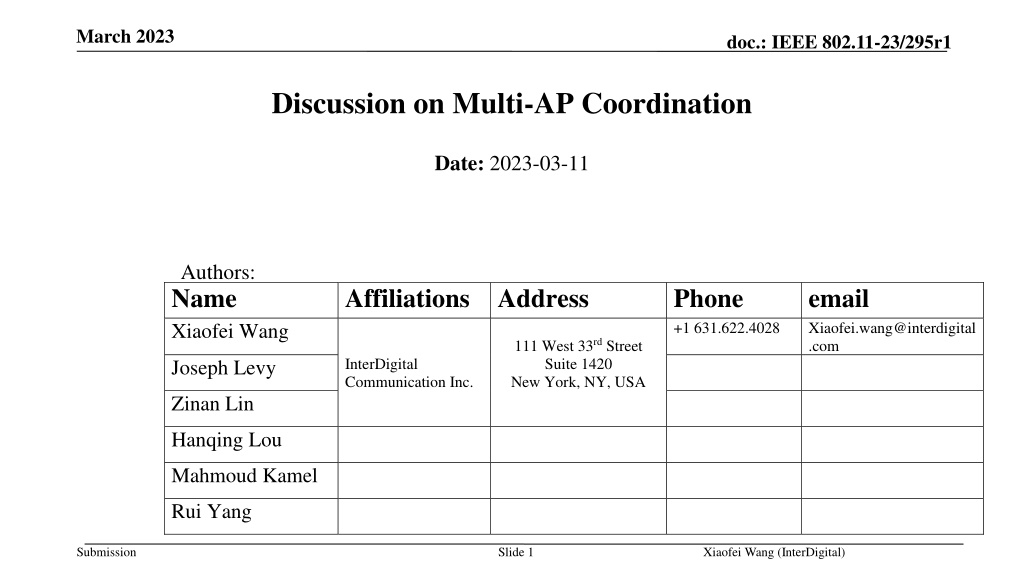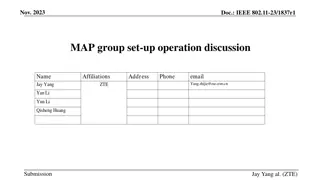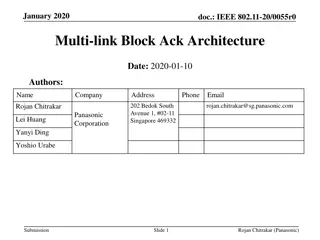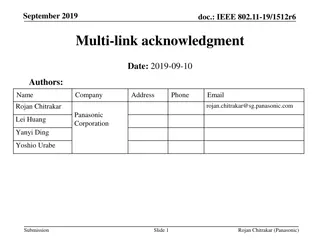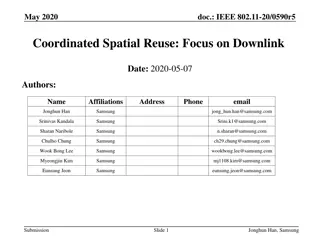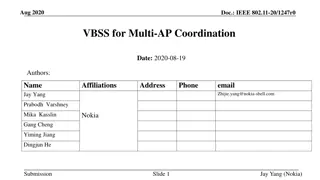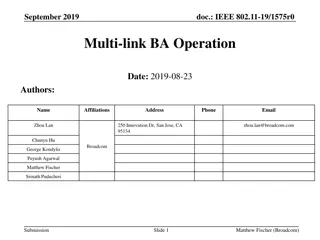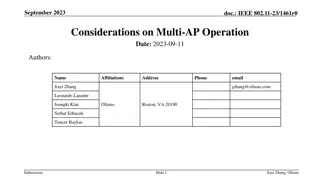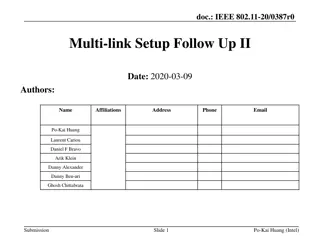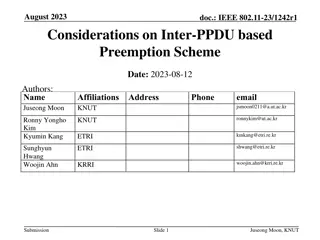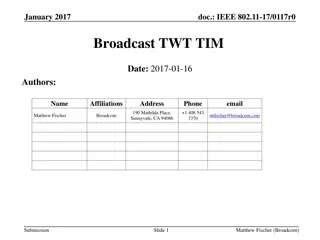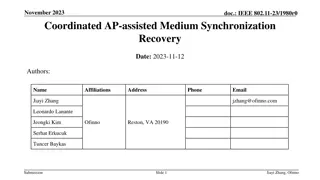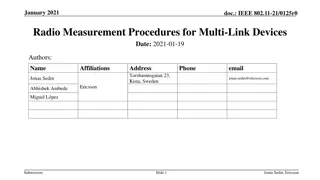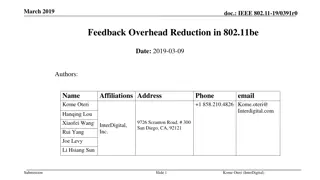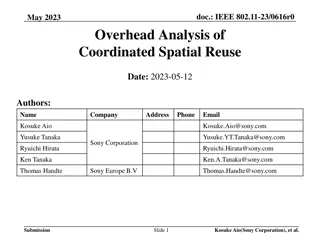Discussion on Multi-AP Coordination Architecture in IEEE 802.11-23
In this document, Xiaofei Wang from InterDigital Communication Inc. discusses the architecture required for multi-AP operations, seamless roaming support, and general MLD operation support in the context of IEEE 802.11-23 standards. The focus is on coordinating various operations across multiple APs that are not co-located, including aspects like Coordinated OFDMA/beamforming and seamless roaming architectures. The discussion evaluates different options for seamless roaming and highlights the pros and cons of each approach, aiming to establish a comprehensive architecture for multi-AP coordination.
Download Presentation

Please find below an Image/Link to download the presentation.
The content on the website is provided AS IS for your information and personal use only. It may not be sold, licensed, or shared on other websites without obtaining consent from the author. Download presentation by click this link. If you encounter any issues during the download, it is possible that the publisher has removed the file from their server.
E N D
Presentation Transcript
March 2023 doc.: IEEE 802.11-23/295r1 Discussion on Multi-AP Coordination Date: 2023-03-11 Authors: Name Xiaofei Wang Affiliations Address InterDigital Communication Inc. Phone +1 631.622.4028 email Xiaofei.wang@interdigital .com 111 West 33rd Street Suite 1420 New York, NY, USA Joseph Levy Zinan Lin Hanqing Lou Mahmoud Kamel Rui Yang Submission Slide 1 Xiaofei Wang (InterDigital)
March 2023 doc.: IEEE 802.11-23/295r1 Abstract In this contribution we share some thoughts on the architecture needed for multi-AP operations, including various coordination operations as well as roaming support, and general MLD operation support. Submission Slide 2 Xiaofei Wang (InterDigital)
March 2023 doc.: IEEE 802.11-23/295r1 Introduction Multi-AP has been proposed as a UHR feature, including coordinated operations such as Coordinated OFDMA/beamforming Coordinated rTWT/TWT Joint transmission Coordinated spatial reuse These multi-AP operations involve APs that are not co-located Seamless roaming support has also been proposed for UHR [1][2][3][4] Seamless roaming support also involves APs that are not co-located Seamless roaming support can be easily viewed as a coordinated multi-AP operation It would be beneficial to have one architecture setup for all multi-AP operations including roaming as well as for general MLD operations An architecture for roaming support only, for example, may be too limiting In this contribution, we want to look at the multi-AP architecture from a general multi-AP coordination point of view Submission Slide 3 Xiaofei Wang (InterDigital)
March 2023 doc.: IEEE 802.11-23/295r1 Seamless roaming discussions Two architectures for seamless roaming have been proposed by previous contributions [1][2][3][4]: Option 1: individual APs that are affiliated with a mobility domain MLD, with the MLD potentially implemented in the DS or with one of the APs [1][2] APs that are not co-located are affiliated with the same MLD Option 2: AP MLDs containing co-located APs while there is an over-arching logical entity (e.g., a roaming AP MLD) that may provide smooth roaming [3] Co-located APs are affiliated with an AP MLD, while the various AP MLDs that are not co-located share an over-arching roaming AP MLD In this contribution, we want to look at the pros and cons for both options Submission Slide 4 Xiaofei Wang (InterDigital)
March 2023 doc.: IEEE 802.11-23/295r1 Seamless roaming architecture discussions (1) Option 1: individual APs that are affiliated with a mobility domain AP MLD, with the MLD potentially implemented in the DS or with one of the APs Pro: Can support roaming No need to define additional logical entities Con: May not be able to support 11be-level MLD functions Limited number of links Changes and reconfigurations potentially require more delay since MLD functionality may be implemented elsewhere May not be able to support association for EHT non-AP MLDs [4] Not clear whether the mobility domain AP MLD is the same logical entity that provides regular service to non-AP MLDs, or just for roaming Slide 5 Submission Xiaofei Wang (InterDigital)
March 2023 doc.: IEEE 802.11-23/295r1 Seamless roaming architecture discussions (2) Option 2: AP MLDs containing co-located APs while there is an over- arching logical entity (e.g., a roaming AP MLD) that may provide smooth roaming [3] Pro: Can support roaming Can support 11be-level MLD functions Can support association for EHT non-AP MLD Limited changes need to be defined for general AP MLD operations Con: Need to define additional signaling and logical entity that is the over-arching roaming MLD In addition, roaming AP MLD should be transparent to UHR non-AP MLDs for easy discovery of roaming candidates Submission Slide 6 Xiaofei Wang (InterDigital)
March 2023 doc.: IEEE 802.11-23/295r1 Seamless roaming architecture discussions (3) In addition, it is beneficial to evaluate the two options from general multi- AP operations perspective Option 1: individual APs that are affiliated with a mobility domain AP MLD, with the MLD potentially implemented in the DS or with one of the APs Not clear whether this architecture is sufficient to support other multi-AP coordination, or it is just for roaming Need to define mechanisms for multi-AP coordination Option 2: AP MLDs containing co-located APs while there is an over-arching logical entity (e.g., a roaming AP MLD) that may provide smooth roaming [3] Can provides all 11be AP MLD functionalities Need to define additional signaling to support multi-AP coordination, but in our opinion, it is a more natural architecture for coordination between AP MLDs May be reused for support multi-AP operations for 11be AP MLDs using software update Slide 7 Submission Xiaofei Wang (InterDigital)
March 2023 doc.: IEEE 802.11-23/295r1 Conclusions Two architectures for seamless roaming have been proposed by previous contributions [1][2][3]: Option 1: individual APs that are affiliated with a mobility domain MLD, with the MLD potentially implemented in the DS or with one of the APs [1][2] Option 2: AP MLDs containing co-located APs while there is an over-arching logical entity (e.g., a roaming AP MLD) that may provide smooth roaming [3] In this contribution, we looked at the pros and cons for both options From the perspective of seamless roaming support From the perspective of general multi-AP operations From the perspective of general MLD operation support Option 2 provides an architecture that is better for general multi-AP operations including seamless roaming support Submission Slide 8 Xiaofei Wang (InterDigital)
March 2023 doc.: IEEE 802.11-23/295r1 References [1] 11-22/1910r3, Seamless Roaming for UHR, Duncan Ho [2] 11-23/237, Considerations on Seamless Roaming, Insun Jang [3] 11-23/0170, Smooth Roaming, Liwen Chu [4] 11-23/231, Thoughts on Seamless Roaming Under Non-collocated AP MLD Architecture, Guoguang Huang [5] 11-23/324, Roaming Requirements, Brian Hart Submission Slide 9 Xiaofei Wang (InterDigital)
